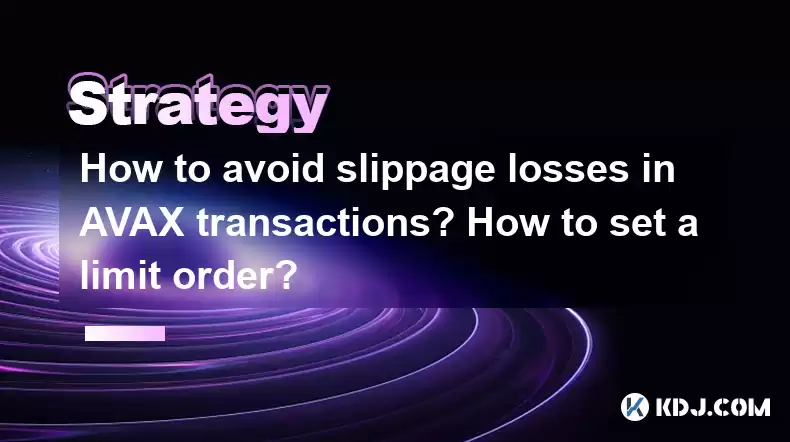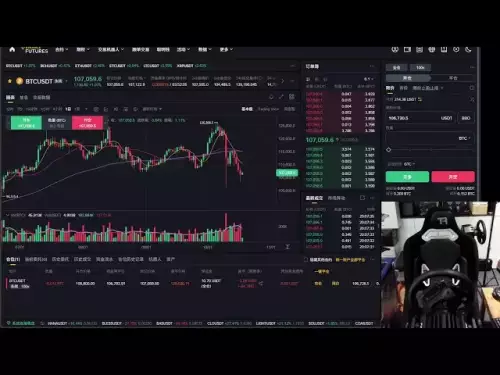-
 bitcoin
bitcoin $106975.071866 USD
-0.29% -
 ethereum
ethereum $3871.670850 USD
-0.07% -
 tether
tether $1.000261 USD
-0.01% -
 bnb
bnb $1084.417621 USD
-0.50% -
 xrp
xrp $2.348167 USD
0.82% -
 solana
solana $185.621736 USD
0.45% -
 usd-coin
usd-coin $0.999833 USD
-0.04% -
 tron
tron $0.313423 USD
0.81% -
 dogecoin
dogecoin $0.188856 USD
0.54% -
 cardano
cardano $0.630416 USD
-0.49% -
 hyperliquid
hyperliquid $36.506353 USD
2.24% -
 ethena-usde
ethena-usde $0.999584 USD
-0.01% -
 chainlink
chainlink $16.750026 USD
-0.77% -
 stellar
stellar $0.313373 USD
0.37% -
 bitcoin-cash
bitcoin-cash $465.978560 USD
-1.57%
How to avoid slippage losses in AVAX transactions? How to set a limit order?
To minimize slippage in AVAX transactions, trade during high liquidity periods, set a reasonable slippage tolerance, and use limit orders to control execution prices.
Apr 29, 2025 at 05:49 am

Slippage in cryptocurrency transactions, including those on the Avalanche (AVAX) network, refers to the difference between the expected price of a trade and the price at which the trade is executed. Slippage can occur due to market volatility or liquidity issues, leading to potential losses for traders. In this article, we will explore strategies to minimize slippage losses in AVAX transactions and provide a detailed guide on setting limit orders, which can help manage slippage effectively.
Understanding Slippage in AVAX Transactions
Slippage is a common phenomenon in decentralized exchanges (DEXs) and can significantly impact the profitability of trades. When you place a market order on a DEX, the order is executed at the best available price at that moment. However, due to the time it takes for the transaction to be processed on the blockchain, the price can change, resulting in slippage.
To minimize slippage in AVAX transactions, it is essential to understand the factors that contribute to it:
- Market Volatility: High volatility can lead to rapid price changes, increasing the likelihood of slippage.
- Liquidity: Low liquidity in the trading pair can result in larger slippage as there may not be enough orders to fulfill your trade at the desired price.
- Transaction Speed: The speed at which your transaction is processed on the blockchain can also affect slippage.
Strategies to Minimize Slippage in AVAX Transactions
There are several strategies you can employ to reduce slippage when trading AVAX:
- Trade During High Liquidity Periods: Liquidity tends to be higher during peak trading hours, reducing the chance of slippage. Monitor liquidity pools and trade when liquidity is optimal.
- Use Slippage Tolerance Settings: Many decentralized exchanges allow you to set a slippage tolerance, which is the maximum percentage of slippage you are willing to accept. Setting a reasonable slippage tolerance can help protect against large price movements.
- Break Large Orders into Smaller Ones: Large orders can significantly impact the market, leading to increased slippage. Splitting large orders into smaller ones can help minimize this effect.
Setting a Limit Order on AVAX
A limit order is a type of order that allows you to specify the exact price at which you want to buy or sell AVAX. By using limit orders, you can control the price at which your trade is executed, effectively managing slippage. Here is a step-by-step guide on how to set a limit order on a DEX that supports AVAX:
- Connect Your Wallet: First, you need to connect your cryptocurrency wallet to the DEX. Ensure your wallet is compatible with the DEX and has sufficient AVAX for transaction fees.
- Navigate to the Trading Interface: Once connected, navigate to the trading interface of the DEX. Select the AVAX trading pair you wish to trade.
- Select Limit Order: On the trading interface, select the option to place a limit order. This option is usually labeled as 'Limit' or 'Limit Order.'
- Set the Price: Enter the price at which you want to buy or sell AVAX. This price will be the maximum you are willing to pay (for a buy order) or the minimum you are willing to accept (for a sell order).
- Set the Amount: Specify the amount of AVAX you want to trade. Ensure you have enough balance in your wallet to cover the trade.
- Review and Confirm: Review your order details carefully. Once satisfied, confirm the order to submit it to the DEX.
Monitoring and Managing Limit Orders
After setting a limit order, it is important to monitor its status and manage it effectively:
- Check Order Status: Regularly check the status of your limit order to see if it has been filled, partially filled, or remains unfilled. Many DEXs provide a dashboard where you can view your active orders.
- Adjust or Cancel Orders: If market conditions change, you may need to adjust your limit order price or cancel it altogether. Navigate to your active orders and select the appropriate action to modify or cancel your order.
- Understand Order Expiration: Some DEXs allow you to set an expiration time for your limit orders. Be aware of this feature and set an appropriate expiration time if available.
Using Advanced Trading Tools
For more experienced traders, using advanced trading tools can further help manage slippage in AVAX transactions:
- Stop-Loss Orders: A stop-loss order can help limit potential losses by automatically selling AVAX if the price drops to a certain level. Set a stop-loss order to protect your investment from significant price drops.
- Take-Profit Orders: Similarly, a take-profit order can help secure profits by automatically selling AVAX when the price reaches a certain level. Use take-profit orders to lock in gains without constantly monitoring the market.
- Automated Trading Bots: Some traders use automated trading bots to execute trades based on predefined criteria. Configure a trading bot to manage your AVAX trades and minimize slippage.
FAQs
Q: Can slippage be completely eliminated in AVAX transactions?A: No, slippage cannot be completely eliminated due to the inherent nature of decentralized exchanges and blockchain technology. However, by using the strategies and tools discussed in this article, you can significantly reduce the impact of slippage on your AVAX trades.
Q: What is the difference between a market order and a limit order in the context of AVAX trading?A: A market order is executed at the best available price at the time of submission, which can lead to slippage. A limit order, on the other hand, allows you to specify the exact price at which you want to buy or sell AVAX, giving you more control over the execution price and helping to manage slippage.
Q: How can I determine the optimal slippage tolerance for my AVAX trades?A: The optimal slippage tolerance depends on various factors, including market volatility and the liquidity of the trading pair. A common practice is to start with a lower slippage tolerance (e.g., 0.5-1%) and adjust it based on your trading experience and the specific conditions of the market.
Q: Are there any risks associated with using limit orders for AVAX transactions?A: Yes, there are risks associated with limit orders. If the market price does not reach your specified limit price, your order may remain unfilled, potentially causing you to miss out on trading opportunities. Additionally, if the market moves rapidly, your limit order may be filled at a less favorable price than expected.
Disclaimer:info@kdj.com
The information provided is not trading advice. kdj.com does not assume any responsibility for any investments made based on the information provided in this article. Cryptocurrencies are highly volatile and it is highly recommended that you invest with caution after thorough research!
If you believe that the content used on this website infringes your copyright, please contact us immediately (info@kdj.com) and we will delete it promptly.
- Eric Trump, Crypto, and Caution: An Aniken Incident Cautionary Tale
- 2025-10-19 12:25:14
- Chainlink's Balancing Act: Bears, Whales, and Key Support Levels
- 2025-10-19 12:25:14
- Chainlink's Tightrope Walk: Bears, Bulls, and the $16 Support
- 2025-10-19 12:30:16
- Arthur Hayes' Maelstrom: A $250M Crypto Buyout Spree Targeting Family Offices
- 2025-10-19 12:30:16
- Decoding Pet Pain: Vet Talk on Misbehaving Pets and Hidden Aches
- 2025-10-19 12:35:11
- Bitcoin, Altcoins, and Crypto Outlook: Navigating Q4 2025's Potential Explosion
- 2025-10-19 12:35:11
Related knowledge

Practical parameter settings for a Bitcoin multi-timeframe moving average system
Sep 18,2025 at 10:54pm
Optimizing Timeframe Combinations for Bitcoin Trading1. Selecting appropriate timeframes is crucial when building a multi-timeframe moving average sys...

How can I filter out false breakouts in Dogecoin high-frequency trading?
Sep 22,2025 at 01:00am
Understanding False Breakouts in Dogecoin Trading1. A false breakout occurs when Dogecoin's price appears to move beyond a defined support or resistan...

Techniques for identifying tops and bottoms in the Bitcoin on-chain NVT model
Sep 20,2025 at 07:54pm
Understanding the NVT Model in Bitcoin Analysis1. The Network Value to Transactions (NVT) ratio is often described as the 'P/E ratio' of the cryptocur...

What does the surge in open interest in Bitcoincoin futures mean?
Sep 20,2025 at 11:18pm
Understanding the Surge in Dogecoin Futures Open Interest1. A surge in open interest within Dogecoin futures indicates a growing number of active cont...

How can I use the Ethereum USDT premium to gauge market sentiment?
Sep 18,2025 at 11:55pm
Understanding the Ethereum USDT Premium1. The Ethereum USDT premium refers to the price difference between USDT (Tether) traded on Ethereum-based plat...

What should I do if Ethereum staking yields decline?
Sep 20,2025 at 06:18am
Understanding the Causes Behind Declining Ethereum Staking Yields1. The Ethereum network transitioned to a proof-of-stake consensus mechanism with the...

Practical parameter settings for a Bitcoin multi-timeframe moving average system
Sep 18,2025 at 10:54pm
Optimizing Timeframe Combinations for Bitcoin Trading1. Selecting appropriate timeframes is crucial when building a multi-timeframe moving average sys...

How can I filter out false breakouts in Dogecoin high-frequency trading?
Sep 22,2025 at 01:00am
Understanding False Breakouts in Dogecoin Trading1. A false breakout occurs when Dogecoin's price appears to move beyond a defined support or resistan...

Techniques for identifying tops and bottoms in the Bitcoin on-chain NVT model
Sep 20,2025 at 07:54pm
Understanding the NVT Model in Bitcoin Analysis1. The Network Value to Transactions (NVT) ratio is often described as the 'P/E ratio' of the cryptocur...

What does the surge in open interest in Bitcoincoin futures mean?
Sep 20,2025 at 11:18pm
Understanding the Surge in Dogecoin Futures Open Interest1. A surge in open interest within Dogecoin futures indicates a growing number of active cont...

How can I use the Ethereum USDT premium to gauge market sentiment?
Sep 18,2025 at 11:55pm
Understanding the Ethereum USDT Premium1. The Ethereum USDT premium refers to the price difference between USDT (Tether) traded on Ethereum-based plat...

What should I do if Ethereum staking yields decline?
Sep 20,2025 at 06:18am
Understanding the Causes Behind Declining Ethereum Staking Yields1. The Ethereum network transitioned to a proof-of-stake consensus mechanism with the...
See all articles





















![[4K 60fps] Astral by oc3andark (1 Coin) [4K 60fps] Astral by oc3andark (1 Coin)](/uploads/2025/10/19/cryptocurrencies-news/videos/k-fps-astral-ocandark-coin/68f438453fa33_image_500_375.webp)




















































